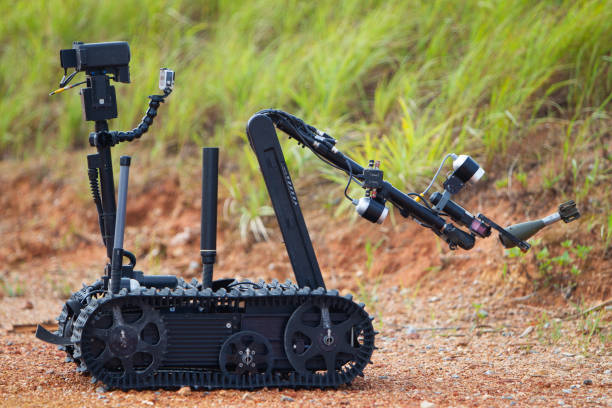
The global military robotics and autonomous systems market is experiencing significant growth, driven by escalating geopolitical tensions, increased defence spending, and rapid technological advancements. In 2024, the market was valued at USD 10.8 billion and is projected to reach USD 24.6 billion by 2033, growing at a CAGR of 9.60% during the forecast period. The integration of advanced technologies, such as artificial intelligence (AI), is enhancing the capabilities of military robotics, leading to improved operational efficiency and effectiveness.
Study Assumption Years
- Base Year: 2024
- Historical Years: 2019-2024
- Forecast Years: 2025-2033
Military Robotics and Autonomous Systems Market Key Takeaways
- Market Size and Growth: The market is projected to grow from USD 10.8 billion in 2024 to USD 24.6 billion by 2033, at a CAGR of 9.60%.
- Technological Integration: Advancements in AI and machine learning are enhancing the capabilities of military robotics, leading to improved decision-making and autonomous operations.
- Regional Dominance: North America holds the largest market share, driven by substantial investments in defense technologies and the presence of major industry players.
- Emerging Markets: Asia Pacific is expected to witness significant growth due to rising defense expenditures and increasing security concerns.
- Application Expansion: Military robotics are increasingly utilized in various applications, including intelligence, surveillance, reconnaissance (ISR), combat, logistics, and search & rescue operations.
Market Growth Factors
- Technological Advancements in AI and Robotics
The integration of AI and machine learning into military robotics is revolutionizing defense operations. These technologies enable autonomous decision-making, real-time data analysis, and enhanced situational awareness. For instance, AI-powered drones can autonomously navigate complex environments, identify targets, and execute missions with minimal human intervention. Such capabilities not only increase operational efficiency but also reduce the risk to human soldiers. The continuous development of advanced sensors, communication systems, and navigation technologies further augments the effectiveness of military robotics.
- Rising Defense Expenditures and Geopolitical Tensions
Global defense budgets are on the rise, fueled by increasing geopolitical tensions and the need for modernized military capabilities. Countries are investing heavily in advanced defense technologies, including autonomous systems, to enhance their strategic advantage. The demand for unmanned systems is particularly high in regions facing security challenges, as these systems offer capabilities such as surveillance, reconnaissance, and combat support without endangering human lives. This trend is significantly contributing to the growth of the military robotics market.
- Expanding Applications in Military Operations
Military robotics are finding applications across a wide range of military operations. In ISR missions, unmanned systems provide real-time intelligence and surveillance capabilities. In combat scenarios, they offer support in terms of firepower and logistics. Additionally, autonomous systems are increasingly used in search and rescue missions, mine detection and clearance, and logistical support. The versatility and adaptability of these systems make them invaluable assets in modern military operations, driving their adoption and market growth.
Request for a sample copy of this report:
https://www.imarcgroup.com/military-robotics-autonomous-systems-market/requestsample
Market Segmentation
By Technology:
- Unmanned Aerial Vehicles (UAVs): Aircraft systems operated without a human pilot onboard, used for surveillance and combat missions.
- Unmanned Ground Vehicles (UGVs): Land-based robots designed for various applications, including reconnaissance and logistics support.
- Autonomous Underwater Vehicles (AUVs): Submersible robots used for underwater surveillance and mine detection.
- Others: Includes hybrid systems and other emerging robotic technologies.
By Operation:
- Fully Autonomous: Systems capable of performing tasks without human intervention.
- Semi-Autonomous: Systems that require some level of human control or supervision.
By Platform:
- Land-Based: Robots designed for ground operations, including reconnaissance and combat support.
- Air-Based: Aerial systems used for surveillance, reconnaissance, and combat missions.
- Sea-Based: Maritime robots used for naval operations, including mine detection and underwater surveillance.
By End Use:
- Military and Defense: Primary users of military robotics for various operational needs.
- Homeland Security: Use of robotics for border security, surveillance, and emergency response.
By Application:
- Intelligence, Surveillance, and Reconnaissance (ISR): Gathering and analyzing information to support military operations.
- Combat: Engaging in offensive and defensive military actions.
- Logistics: Supporting supply chain and transportation needs in military operations.
- Search & Rescue: Locating and assisting individuals in distress during military missions.
- Mine Detection & Clearance: Identifying and neutralizing landmines and other explosive devices.
- Others: Additional applications such as training and simulation.
Breakup by Region:
- North America (United States, Canada)
- Asia Pacific (China, Japan, India, South Korea, Australia, Indonesia, Others)
- Europe (Germany, France, United Kingdom, Italy, Spain, Russia, Others)
- Latin America (Brazil, Mexico, Others)
- Middle East and Africa
Regional Insights
North America dominates the military robotics and autonomous systems market, driven by substantial investments in defense technologies and the presence of major industry players. The region’s focus on modernizing military capabilities and integrating advanced technologies contributes significantly to market growth. Additionally, supportive government initiatives and increased defense spending further bolster the market in this region.
Recent Developments & News
The military robotics and autonomous systems market is witnessing several notable developments:
- Boeing and Sagar Defence Engineering Collaboration: In September 2024, Boeing partnered with Sagar Defence Engineering to develop advanced unmanned systems, enhancing capabilities in the Indian defense sector.
- IAI and Aerotor Unmanned Systems Agreement: In April 2024, Israel Aerospace Industries (IAI) and Aerotor Unmanned Systems signed a memorandum of understanding to advance unmanned aerial system technologies, focusing on integrating Aerotor’s Apus multicopter with IAI’s expertise in aviation and unmanned platforms.
Key Players
AeroVironment, Inc., Applied Intuition Government, Inc., BAE Systems, Elbit Systems Ltd., Ghost Robotics Corporation, Israel Aerospace Industries (IAI), Lockheed Martin Corporation, Milrem Robotics, Northrop Grumman, QinetiQ, Rheinmetall AG, Teledyne FLIR LLC, Thales, etc.
Ask Analyst for Customization:
https://www.imarcgroup.com/request?type=report&id=22291&flag=C
If you require any specific information that is not covered currently within the scope of the report, we will provide the same as a part of the customization.
About Us:
IMARC Group is a global management consulting firm that helps the world’s most ambitious changemakers to create a lasting impact. The company provides a comprehensive suite of market entry and expansion services. IMARC offerings include a thorough market assessment, feasibility studies, company incorporation assistance, factory setup support, regulatory approvals and licensing navigation, branding, marketing and sales strategies, competitive landscape, and benchmarking analyses, pricing and cost research, and procurement research.
Contact Us:
IMARC Group
134 N 4th St. Brooklyn, NY 11249, USA
Email: sales@imarcgroup.com
Tel No:(D) +91 120 433 0800
United States: +1-631-791-1145





